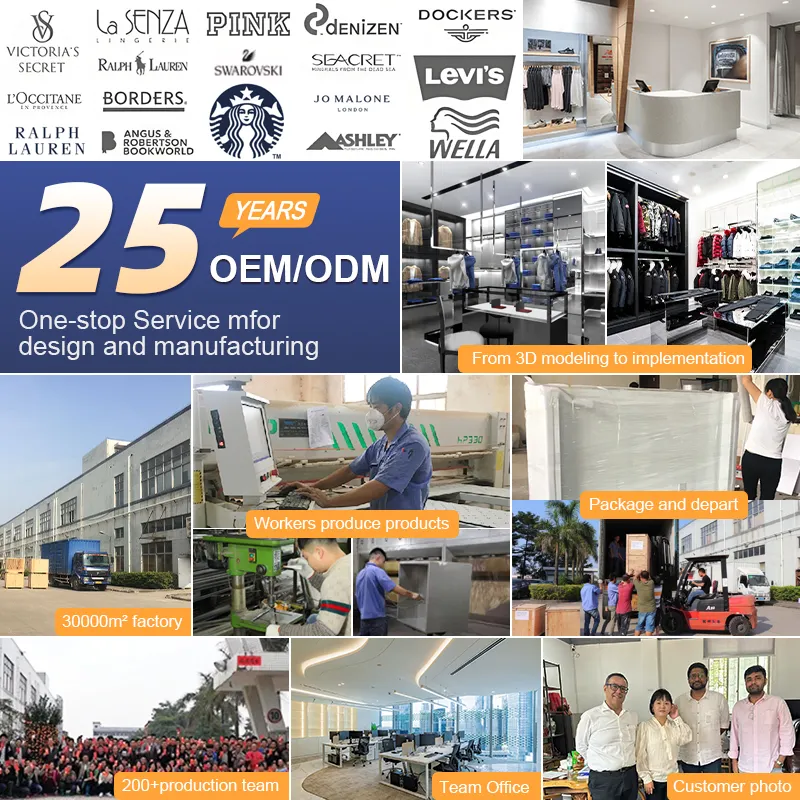How to Reflect the Unique Charm of Cigar Culture in Store Fixtures? — An In-Depth Integration Guide from Atmosphere to Details
To truly capture this charm in store decoration, we must move beyond superficial ornamentation and deeply align every aspect — from spatial atmosphere and material selection to functional design and detailed symbols — with the core logic of cigar culture.
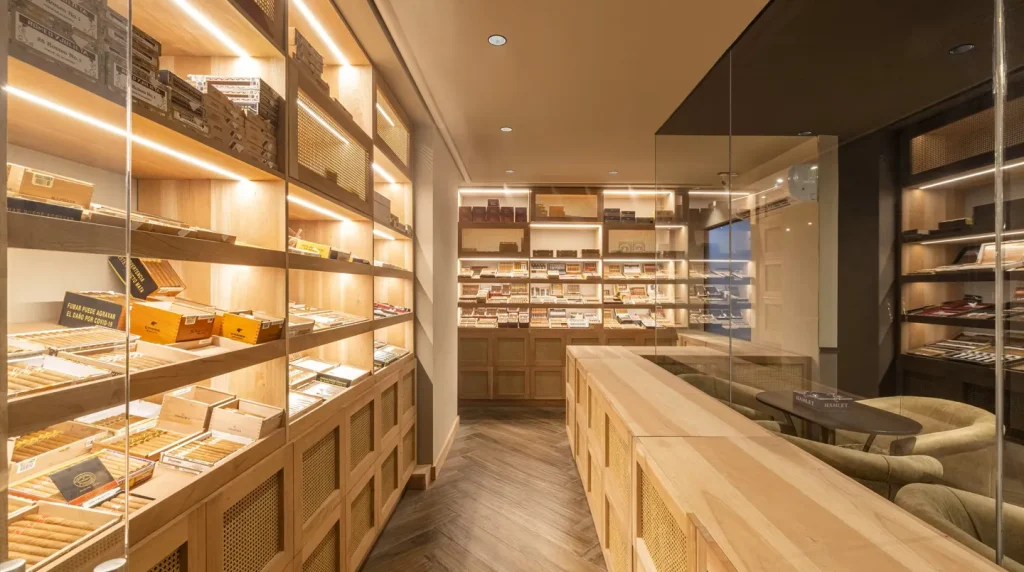
I. Define the "Atmospheric Tone" First: Align with the "Calmness and Deliberation" of Cigars
1.Lighting: Reject Bright Direct Light; Create a Relaxing Vibe with “Warm Light Envelopment”
Core Logic: Strong light damages the visual texture of cigars (e.g., the glossy luster of cigar wrappers) and makes the space feel restless. Soft warm light complements the dark brown tones of cigars while encouraging a relaxed pace.
Practical Approaches:
For primary lighting, choose warm yellow light with a color temperature below 3000K (avoid cool white light). Prioritize “indirect lighting” — such as recessed downlights with frosted shades, vintage brass chandeliers (with cigar or tobacco leaf textures on the arms), and wall sconces (angled toward walls or floors to avoid direct eye glare).
Design targeted local lighting: Use narrow-beam spotlights in display areas (to highlight details of cigar wrappers) and small-range pendant lights above coffee tables in tasting zones (to help customers monitor cigar combustion), but keep brightness at a level where “cigars are visible without causing eye strain.”
Avoid large glass skylights or reflective white walls. If windows exist, pair them with thick linen or velvet curtains to adjust light during the day and block external distractions at night, enhancing the space’s “sense of privacy.”
2.Colors: Center on “Cigar Color Palettes”; Avoid Gaudy Hues
Core Logic: Color is a “visual symbol” of culture. The wrapper of cigars (dark brown, dark red, light brown), tobacco leaves (yellow-green, ochre), and traditional storage environments (wooden brown, dark brown leather) have long defined their exclusive “color language.”
Safe Color Matching Formula:
Base Color (60%): Low-saturation neutrals such as off-white, light brown, and dark gray (for walls/floors). Avoid large areas of pure white (feels cold) or pure black (feels oppressive).
Main Color (30%): Dark brown tones that echo cigars, such as walnut brown, cherry wood brown, and dark coffee (for furniture, cigar display cabinets, and door frames).
Accent Color (10%): Brighten with low-saturation “culturally relevant colors,” such as Cuban green (echoing tobacco leaves), dark red (echoing cigar wrapper textures), and brass (echoing vintage accessories). Avoid garish hues like bright yellow or royal blue (which disrupt the calm vibe).
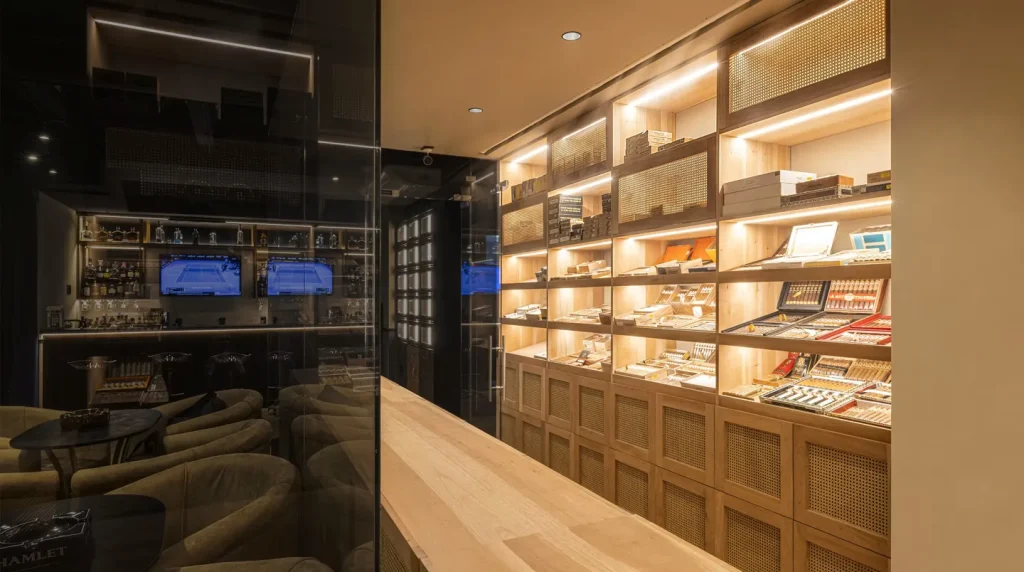
II. Choose the Right "Materials": Sync Texture with Cigar Culture
1.Solid Wood: The “Primary Material” of Cigar Culture, Balancing Function and Sentiment
Core Logic: Solid wood not only has a warm texture (echoing the natural feel of cigar wrappers) but also regulates spatial humidity (cigars require 55%-75% humidity; the breathability of solid wood helps stabilize the environment). Its “glossier-with-use” characteristic mirrors the “time-honed quality” of cigar culture.
Recommended Types and Uses:
Display/Storage Areas: Select walnut, cherry wood, or teak (high hardness, fine grain) for built-in wooden cigar cabinets and open cigar display stands. Avoid veneers (cheap texture and non-breathable).
Floors/Walls: Choose matte solid wood flooring (to avoid glare) or partial solid wood wall panels (e.g., behind the bar or in tasting areas). If budget is limited, wood veneer can be used as a substitute, but ensure the grain looks natural.
2.Leather: Enhance “Refined Ritual”; Echo the “Luxury Attribute” of Cigars
Core Logic: Cigar appreciation scenarios are often tied to “high-end socializing.” The soft touch and luster of leather elevate the space’s “luxury” while its durability suits high-frequency use areas (e.g., seating, tabletops).
Practical Uses:
Tasting Areas: Opt for dark brown or dark green top-grain leather sofas (with slightly curved armrests for a more vintage look) and leather-upholstered walls (used partially, such as behind sofas, to reduce the “hardness” of the space).
Details: Wrap the edges of bar countertops in leather, use leather storage boxes for cigar accessories display, and even line ashtray edges with leather (to avoid the coldness of metal).
3.Metal: Accent with “Vintage Metal”; Reject Industrial Style
Core Logic: Metal elements add sophistication but should avoid modern, shiny stainless steel or aluminum. Instead, choose vintage metals with an “oxidized texture” to echo classic designs of cigar accessories (e.g., brass lighters, antique bronze cigar cutters).
Recommended Types and Uses:
Brass/Antique Bronze: Use for chandelier frames, cigar display cabinets handles, bar metal legs, picture frames for wall decor, and even humidor latches (adding texture to small details).
Matte Black Iron: For “industrial vintage styles,” it can be used for open cigar display stands frames — but pair with solid wood boards to avoid the coldness of all-metal designs.
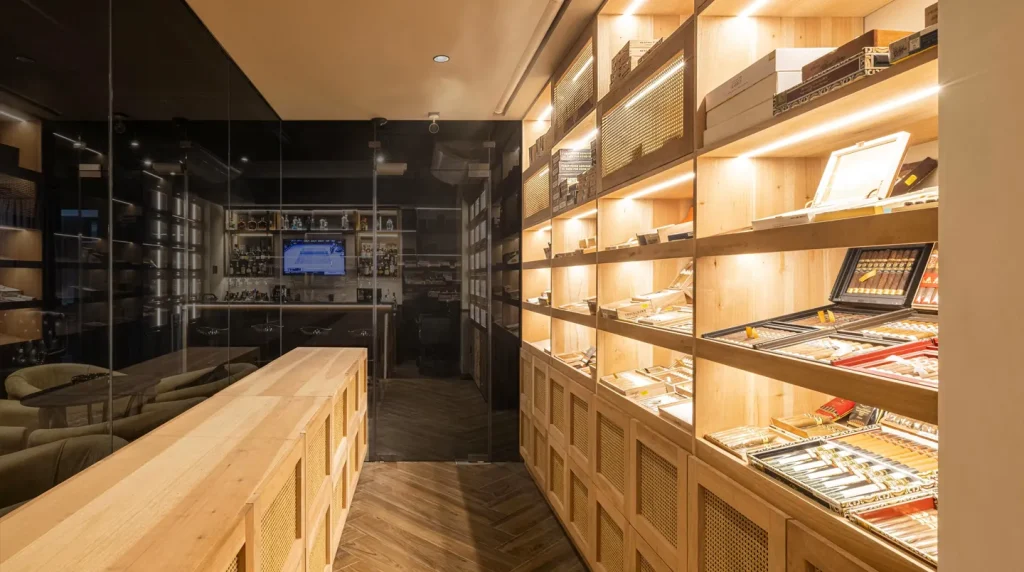
III. Functional Zone Design: Let the "Cigar Ritual" Unfold Naturally
1.Display/Storage Areas: Both “Showcase Windows” and “Cultural Carriers”
Core Requirement: Ensure professional cigar storage (constant temperature and humidity) while conveying “cigar expertise” through display — letting customers immediately recognize “this is a store that understands cigars.”
Design Key Points:
Humidors: Prioritize built-in solid wood humidors (integrated with the overall style to avoid the awkwardness of standalone coolers). Use anti-fog tempered glass for doors (so customers can clearly see internal cigars), install warm light strips inside (to highlight the gloss of cigar wrappers), and attach clear labels (indicating origin: Cuba/Dominican Republic/Nicaragua, brand, and wrapper type: Corojo/Maduro, etc.).
Open Cigar Display Stands: Used to display “non-storage” cigar cultural symbols, such as:
Cigar boxes of different sizes (vintage wooden boxes, metal boxes — showcasing cigar packaging culture).
Cigar accessories display (brass cutters, wooden lighters, leather ashtrays — paired with small cards explaining their uses).
Tobacco leaf specimens (dried cigar leaves framed in glass to visually display cigar raw materials).
2.Tasting Areas: Create a Core Scenario for “Socializing + Slow Savoring”
Core Requirement: Cigars have strong social attributes, so tasting areas must accommodate both “solitary relaxation” and “group communication” while facilitating customers’ “lighting, savoring” actions.
Design Key Points:
Layout: Avoid rigid “row seating” and prioritize “enclosed small group setups” — such as 2-3 person leather sofas with round solid wood coffee tables (large enough for cigars, ashtrays, and drinks) or high stools at the bar (suitable for solo savoring and easy communication with bartenders).
Detailed Configurations:
Reserve “cigar rests” on coffee tables (metal or wooden, to prevent cigars from touching the table directly) and lidded ashtrays (to prevent ash from scattering and isolate odors).
Set up a “lighting area” nearby (away from drafts, equipped with professional cigar lighters — fixed on walls or beside coffee tables for easy access).
If space allows, add a “small cigar cutting station” (solid wood countertop with a fixed clamp, making it easy for customers to cut cigars on-site and enhance ritual).
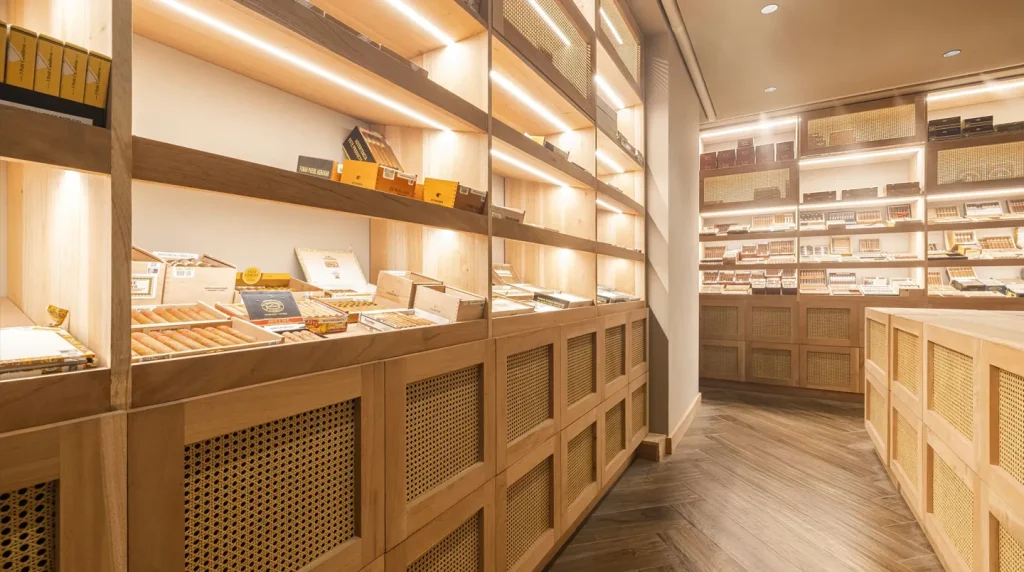
IV. Detailed Decor: Awaken Cigar Culture Memories with "Symbolic Elements"
Details are the “code of culture” — small elements related to cigar origins, history, and craftsmanship allow customers to instantly associate with core cigar culture scenarios and are more impactful than large-scale decorations.
1.Wall Decor: Hang “Storytelling Art” Instead of Generic Decorative Paintings
Recommended Choices:
Cigar Origin Maps: Vintage-style maps of Cuba/the Caribbean (marking core producing regions), hand-drawn or aged-printed, with brass or solid wood frames.
Cigar Craft Illustrations/Vintage Photos: Scenes like “artisans hand-rolling cigars” or vintage photos of early 20th-century European gentlemen tasting cigars in clubs.
Vintage Cigar Advertisement Posters: Old posters of Cuban brands like Cohiba or Montecristo (use reprints) with colors matching the space.
2.Ornaments and Scents: Enhance Immersion with “Sight + Smell”
Visual Ornaments:
Small Tobacco Barrels: Vintage wooden/metal tobacco barrels (decorative only — echoing cigar raw material storage scenarios).
Cigar Molds: Wooden molds used to shape cigars during production (visually demonstrating craftsmanship details).
Regional Cultural Symbols: For stores focusing on Cuban cigars, add small Cuban flag ornaments or rum bottles.
Scent Control:
Avoid strong aromatherapy. Use “flameless diffusers” in corners (scented with “cedar, sandalwood, or light wood tones”).
If the space has ventilation systems, lightly retain a “faint cigar aftertaste” (clean regularly) — the most direct “cigar culture signal.”
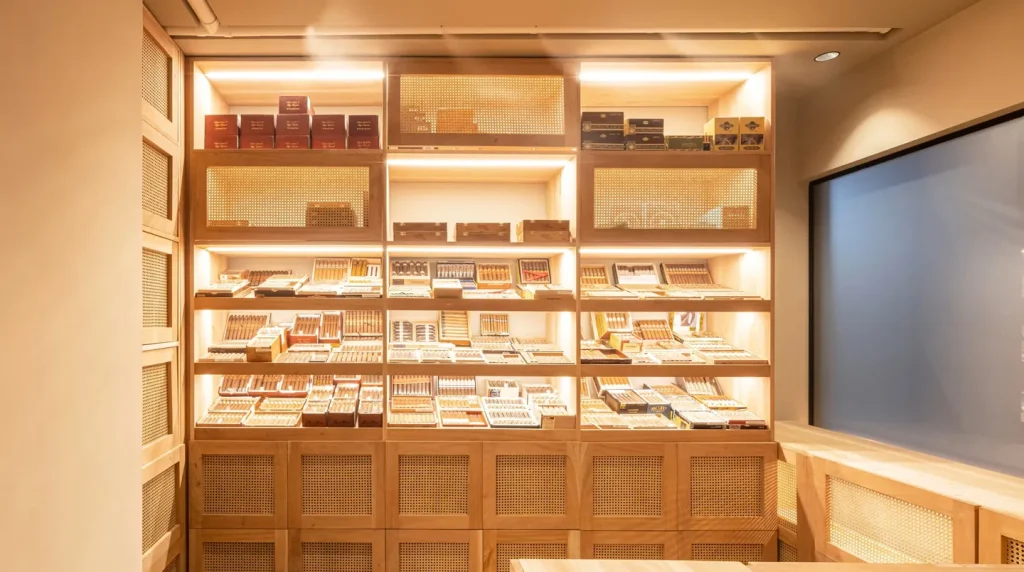
V. Sound Atmosphere: Set the Cultural Scene with "Background Music"
Sound is “invisible decoration” that quickly builds connection. Background music for cigar culture should match the “slow savoring” rhythm.
Recommended Genres:
Jazz: Soft saxophones and pianos create a “vintage gentlemen’s club” vibe.
Traditional Cuban Music: Mellow salsa or trova — ideal for stores focusing on Cuban cigars.
Classical Music: Chamber music, elegant without overpowering.
Notes: Keep volume at a level where “conversations are audible while music is still present.” Avoid pop or electronic music.
VI. Avoid "Pitfalls": Don’t Let These Details Ruin the Cultural Vibe
Reject “Element Piling”: Hanging a few cigar posters or placing solid wood cabinets does not equal “cigar culture.” A chaotic overall style looks cheap.
Don’t Neglect “Practicality”: A humidor that prioritizes appearance over functional temperature/humidity control will spoil cigars.
Avoid “Excessive Modernization”: For a “modern minimalist style,” simplify lines but retain the texture of core materials (e.g., solid wood, leather).
Respect “Regional Cultural Differences”: For stores focusing on Cuban cigars, incorporate more Cuban elements. Avoid “cultural misalignment.”
Conclusion: Cultural Charm Lies in "Logical Consistency"
Decoration that truly reflects cigar culture is not about “piling vintage elements” but “designing every detail around the customer’s experience and the logic of cigar appreciation.” When “atmosphere, materials, functions, and details” all revolve around the “slowness and refinement of cigars,” cultural charm will flow naturally.
👉 Get in touch with us today to start your project.
📞 WhatsApp/Call: +86 186 2096 3396
📧 Email: sales1@onishopfitting.com
🌐 Website: www.onidisplay.com | www.onishopfitting.com
📍 Factory Location: Guangzhou, China
🔗Check out our social media case studies:Guangzhou ONI Shopfitting Limited
